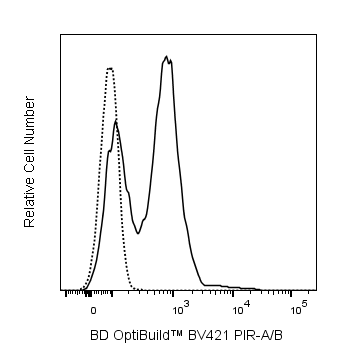Old Browser
This page has been recently translated and is available in French now.
Looks like you're visiting us from {countryName}.
Would you like to stay on the current country site or be switched to your country?




Flow cytometric analysis using BD OptiBuild™ BV421 Rat Anti-Mouse PIR-A/B antibody (Cat. No. 744838; solid line histogram) on live BALB/c mouse splenocytes, with Isotype Control (dotted line histogram). Flow cytometry was performed using a BD LSRFortessa™ X-20 Flow Cytometer System.


BD OptiBuild™ BV421 Rat Anti-Mouse PIR-A/B

Regulatory Status Legend
Any use of products other than the permitted use without the express written authorization of Becton, Dickinson and Company is strictly prohibited.
Preparation And Storage
Recommended Assay Procedures
For optimal and reproducible results, BD Horizon Brilliant Stain Buffer should be used anytime two or more BD Horizon Brilliant dyes (including BD OptiBuild Brilliant reagents) are used in the same experiment. Fluorescent dye interactions may cause staining artifacts which may affect data interpretation. The BD Horizon Brilliant Stain Buffer was designed to minimize these interactions. More information can be found in the Technical Data Sheet of the BD Horizon Brilliant Stain Buffer (Cat. No. 563794).
Product Notices
- This antibody was developed for use in flow cytometry.
- The production process underwent stringent testing and validation to assure that it generates a high-quality conjugate with consistent performance and specific binding activity. However, verification testing has not been performed on all conjugate lots.
- Researchers should determine the optimal concentration of this reagent for their individual applications.
- An isotype control should be used at the same concentration as the antibody of interest.
- Caution: Sodium azide yields highly toxic hydrazoic acid under acidic conditions. Dilute azide compounds in running water before discarding to avoid accumulation of potentially explosive deposits in plumbing.
- For fluorochrome spectra and suitable instrument settings, please refer to our Multicolor Flow Cytometry web page at www.bdbiosciences.com/colors.
- Please refer to www.bdbiosciences.com/us/s/resources for technical protocols.
- BD Horizon Brilliant Stain Buffer is covered by one or more of the following US patents: 8,110,673; 8,158,444; 8,575,303; 8,354,239.
- BD Horizon Brilliant Violet 421 is covered by one or more of the following US patents: 8,158,444; 8,362,193; 8,575,303; 8,354,239.
- Pacific Blue™ is a trademark of Molecular Probes, Inc., Eugene, OR.
Companion Products






The 6C1 monoclonal antibody specifically recognizes the common epitopes of PIR-A and PIR-B (Paired Immunoglobulin-liked Receptors) in all mouse strains tested (A/J, BALB/cJ, C3H, C57BL/6, DBA/1, DBA/2, NZB, and SJL). PIR-A and PIR-B are type-I transmembrane glycoproteins containing six Ig-like domains. There are multiple PIR-A proteins which are activating receptors by virtue of their intracellular association with the ITAM (Immunoreceptor Tyrosine-based Activation Motif)- containing Fc receptor γ chain (FcRγ) in mast cells and macrophages. FcRγ expression is required for PIR-A cell-surface expression on dendritic cells, B cells, and myeloid lineages. In contrast, PIR-B is an inhibitory receptor which contains various ITIMs (Immunoreceptor Tyrosine-based Inhibitory Motifs) in its cytoplasmic domain. These receptors are expressed on B cells, granulocytes, mast cells, dendritic cells, and monocytes/macrophages, but not on thymocytes, T lymphocytes, erythroid lineage cells, or NK cells. The level of cell-surface expression of these receptors increases as a function of B-cell activation and myeloid- and B-lineage differentiation. The 6C1 antibody immunoprecipitates molecules of 85- and 125-kDa, which correspond to PIRA and PIR-B, respectively.
The antibody was conjugated to BD Horizon™ BV421 which is part of the BD Horizon Brilliant™ Violet family of dyes. With an Ex Max of 407-nm and Em Max at 421-nm, BD Horizon BV421 can be excited by the violet laser and detected in the standard Pacific Blue™ filter set (eg, 450/50-nm filter). BD Horizon BV421 conjugates are very bright, often exhibiting a 10 fold improvement in brightness compared to Pacific Blue conjugates.

Development References (6)
-
Bléry M, Kubagawa H, Chen CC, Vély F, Cooper MD, Vivier E. The paired Ig-like receptor PIR-B is an inhibitory receptor that recruits the protein-tyrosine phosphatase SHP-1. Proc Natl Acad Sci U S A. 1998; 95(5):2446-2451. (Biology). View Reference
-
Chen CC, Hurez V, Brockenbrough JS, Kubagawa H, Cooper MD. Paternal monoallelic expression of the paired immunoglobulin-like receptors PIR-A and PIR-B. Proc Natl Acad Sci U S A. 1999; 96(12):6868-6872. (Clone-specific). View Reference
-
Kubagawa H, Burrows PD, Cooper MD. A novel pair of immunoglobulin-like receptors expressed by B cells and myeloid cells. Proc Natl Acad Sci U S A. 1997; 94(10):5261-5266. (Biology). View Reference
-
Kubagawa H, Chen CC, Ho LH. Biochemical nature and cellular distribution of the paired immunoglobulin-like receptors, PIR-A and PIR-B. J Exp Med. 1999; 189(2):309-318. (Immunogen). View Reference
-
Maeda A, Kurosaki M, Kurosaki T. Paired immunoglobulin-like receptor (PIR)-A is involved in activating mast cells through its association with Fc receptor gamma chain. J Exp Med. 1998; 188(5):991-995. (Biology). View Reference
-
Taylor LS, McVicar DW. Functional association of FcepsilonRIgamma with arginine(632) of paired immunoglobulin-like receptor (PIR)-A3 in murine macrophages. Blood. 1999; 94(5):1790-1796. (Biology). View Reference
Please refer to Support Documents for Quality Certificates
Global - Refer to manufacturer's instructions for use and related User Manuals and Technical data sheets before using this products as described
Comparisons, where applicable, are made against older BD Technology, manual methods or are general performance claims. Comparisons are not made against non-BD technologies, unless otherwise noted.
For Research Use Only. Not for use in diagnostic or therapeutic procedures.
Report a Site Issue
This form is intended to help us improve our website experience. For other support, please visit our Contact Us page.